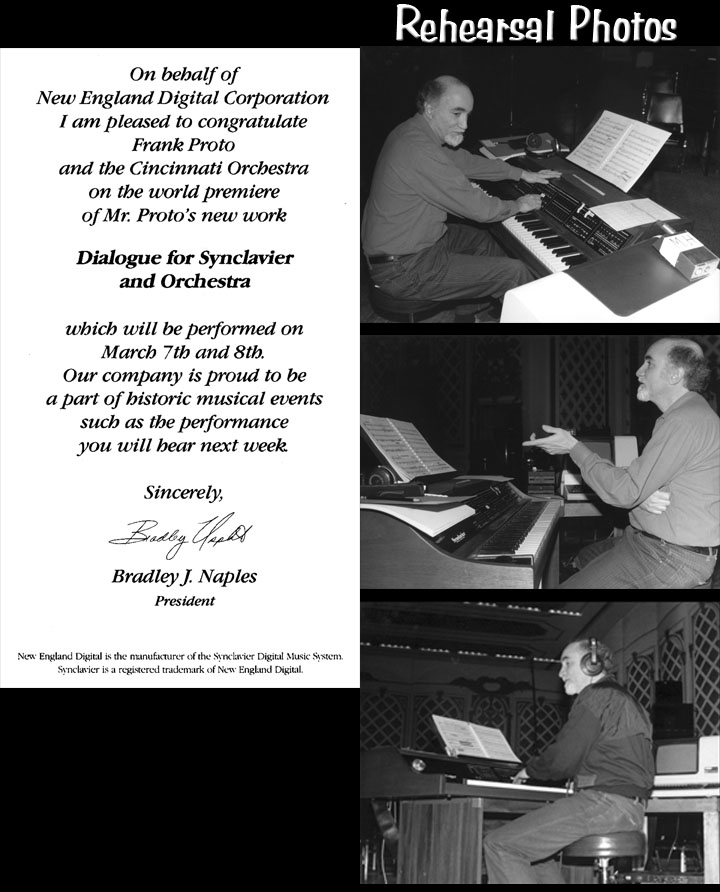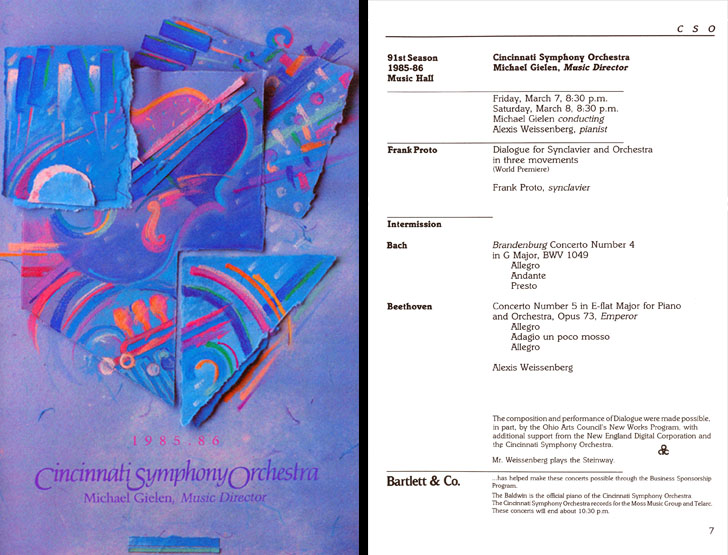
|
Dialogue for Synclavier and Orchestra - World Premiere
Cincinnati Symphony Orchestra.
Catalog Information For Orchestra Score

Program Note by Jonathan Kramer
Cincinnati Symphony Orchestra
Program Booklet - March 7 and 8, 1986.
Frank Proto’s involvement with electronic music goes back many years. "When I was nine years old, my dad brought home a Pentron tape recorder and I took it apart and put it back together. It fascinated me. I was writing electronic music in junior high school and always bought whatever kind of synthesizer I could afford. This is a kind of musical activity that I’ve always wanted to be involved in - using the best new technology to expand beyond the conventional limits of creativity."
Today Proto owns what is perhaps the most versatile electronic music system in existence, the Synclavier. A Synclavier is a computer dedicated to making and storing musical sounds. The instrument works on the principle known as sampling, the technique behind digital recording. When a sound is sampled, it is represented by a sequence of numbers in the computer’s memory. The numbers stand for the wave form that determines the sound. When the Synclavier samples a French horn, for example, the results is 50,000 numbers in memory for each second of sound. If these numbers are then translated back into sound, the result is a high quality digital reproduction of the original French horn. More interesting than simply reproducing sounds, however, is changing them.
Once these numbers exist, they can be altered in a process known as resynthesis. Slight modifications to a small percentage of the numbers can produce a sound still recognizable as a French horn but modified in some manner. The horn timbre can be made to do things that a real horn could never achieve - wide vibrato, rapidly changing tone quality, or long glissandos are just some of the possible effects. The more the numbers are changed, the more the horn sound is transformed, until the timbre becomes completely electronic.
The Synclavier can also synthesize new sounds from scratch. By specifying loudness, pitch, overtones, and how these (and other more complex variables) change during a note, Proto can create unique timbres. Composing thus becomes more than the mere combination of known sounds. The composer working with a sophisticated computer music system creates the sonorities as well as as the music. As Proto has remarked, "Everything is becoming possible now, if we’re willing to learn how to use the technology at our fingertips. Who knows what we’ll be able to create in the coming years?"
In addition to recording, synthesizing, and resynthesizing sounds by means of sampling, the Synclavier can print music. During the process of composing Dialogue, Proto played the orchestra’s music on the Synclavier’s keyboard (which looks like a piano keyboard). The composition was thus entered into the computer’s memory. It could then appear on the monitor (like a television screen) in normal musical notation. Proto then studied the notation and made any changes or additions he wished. When he was satisfied with the look of a particular passage, he gave the computer an instruction to print the music, and out came a finished orchestral score. Another set of commands resulted in the printing of each individual instrument’s part. The Synclavier is thus music’s equivalent of the word processor. It enabled Proto to combine the tasks of composing, editing, and copying, thus saving countless hours of menial labor. And he was able to save the huge fees music copyists typically charge. Copying the score and parts for a piece like Dialogue by hand would traditionally require several months of labor and cost between $10,000 and $20,000.
The Synclavier has a third function as well. It is the solo instrument that Proto plays in tonight’s performance of this concerto-like composition. In this capacity the Synclavier is almost like a traditional instrument. Proto is able to play with all the musical nuance and interpretation that come from his background as an expressive performer. He plays on the Synclavier’s keyboard, foot pedals and glissando strip (which allows for continuous pitch change). In addition, he manipulates buttons and enters commands from a teletype keyboard. These commands select which of the myriad of recorded and synthesized tone colors stored in the computer memory will be reproduced as he plays the instrument.
Keynote Dialogue begins with the orchestra expanding outward from a narrow band of sound to a harmony covering a wide range. This gesture underlies much of the subsequent music, both for orchestra and Synclavier. Shortly after the opening, the Synclavier makes a percussive sound that is a good example of resynthesis. It was produced by sampling and then combining the sounds of a bass drum and a gong. The sonority begins as a drum and ends as a gong.
A dialogue follows between the orchestra horn and the resynthsized Synclavier horn. The electronic timbre starts as a faithful reproduction of the real horn, but the tone quality changes as the music goes on. Proto refers to this effect as "coming in and out of reality."
The slow second movement opens with an extended Synclavier solo, using resynthesized percussion sounds and voice-like sounds, in addition to purely electronic timbres.
In the jazzy third movement Proto plays resynthsized drum sounds on the Synclavier while the orchestra’s percussionists play real drums. The result is a wild melange of percussion that could never be played by real drummers alone. This movement also contains sounds resynthsized from the percussion section’s triangle. The triangle produces a high, metallic sound which does not change in pitch. The resynthesized version of the sound changes pitch as the Synclavier makes the triangle seem to do the impossible - play melodies. We also hear electronically altered triangle sounds.
Throughout the three movements of dialogue there are numerous ingenious uses of resynthesis to create dialogues between electronic and nonelectronic sounds. The music - somethime jazzy, sometimes "legit": sometimes improvised, sometimes notated; sometimes contemplative, sometimes exciting - is alive, engaging, and human. These are qualities not often associated with electronic music, but both Proto’s mastery of the medium and his commitment to use sophisticated technology in a thoroughly musical manner have combined to produce a wonderful piece of music. Electronic music has been in existence for three decades, and Dialogue shows it has finally passed beyond the phase of experimentation. Today the technology is available to provide tryly musical possibilities to the creative composer-performer. Proto has taken full advantage of his machine’s capabilities, and he has composed a piece appropriate to its medium. Through the technique of resynthesis he has created a link between traditional instrumental performance and electronic innovations. Electronics need no longer be feared as a threat to normal musical performance. Thanks to music like Dialogue, the two can be seen as partners in the ongoing development of the musical tradition.
The composition and performance of Dialogue were made possible in part through the generosity of the Ohio Arts Council’s New Works Program, the New England Digital Corporation (manufacturer of the Synclavier), and the Cincinnati Symphony Orchestra. The work is dedicated to Michael Gielen.


Frank Proto
Dialogue for Synclavier and Orchestra
...Composer/soloist Proto, whose compositions range from a string quartet commissioned by the Blair Quartet to Casey at the Bat (a work for narrator and orchestra), presided at the piano-like keyboard and video terminal. The conductor was Cincinnati Symphony music director Michael Gielen.
Scored
for large orchestra, Dialogue is neither a demonstration piece nor a
concerto. Rather, the Synclavier is used as an extension of the
orchestra. Creating doubt in the listener's mind is one of Proto's
primary objectives. Was that the solo horn or the Synclavier imitating
the horn? During a lively interchange with the orchestra triangle, Proto
tipped his hand by having his "triangle" produce pitches. Partly
improvised, partly notated, with lots of percussion and lively rhythms,
the forty-minute, three-movement work bears a debt to jazz as
Stravinsky's "Le Sacre." While it highlights the Synclavier's
capabilities - sampling and re-synthesis of sounds, synthesis of new
sounds, etc. - it illustrates even more dramatically the centrality of
the live performer. Whether coordinating pre-recorded sequences with the
conductor's beat (which, unlike tape, can be done without altering the
pitch), or performing directly on the keyboard, Proto exercised
immediate, expressive control over the instrument. Both orchestra and
conductor met the challenges of the work with professional elan.
Mary Ellyn Hutton
Musical America


